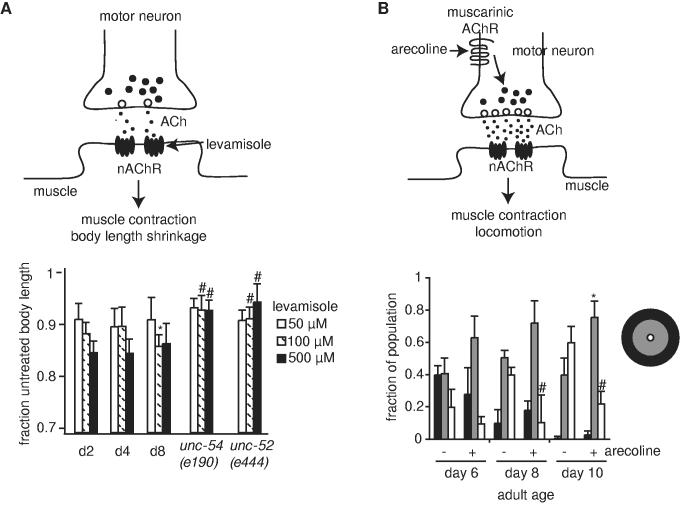Figure 5.
Muscle contraction was similar between days 2 and 8 of adulthood and locomotory behavior in old animals was improved by increasing neuromuscular signaling. (A) Body length shrinkage after treatment with levamisole is a measure of muscle function. (Upper panel) Acetylcholine (ACh, small circles in synapse), released from vesicles in pre-synaptic motor neurons, activates nicotinic acetylcholine receptors on the post-synaptic cells (nAChR, black oval shapes in muscle membrane). Levamisole stimulates nAChRs directly, leading to muscle contraction and body shrinkage. (Lower panel) Body length shrinkage in fem-1(hc17), at days 2, 4, and 8 of adulthood, or locomotion-defective mutants, unc-52(e444) and unc-54(e190), as young adults. The unc-52(e444) and unc-54(e190) mutations both significantly impair mobility and result in abnormal sarcomere structure, and both strains exhibited defects in body shrinkage with levamisole. White bars, 50 μM levamisole; hatched bars, 100 μM levamisole; black bars, 500 μM levamisole; *p<0.05 vs day 2 fem-1(hc17); # p<0.001 vs day 2 and day 8 fem-1(hc17). (B) Arecoline treatment improved locomotory behavior in aged animals. (Upper panel) Arecoline is an agonist of muscarinic acetylcholine receptors. Arecoline treatment stimulates acetylcholine release by motor neurons. In control experiments, arecoline treatment increased paralysis of wildtype day 8 animals by aldicarb, consistent with the expectation that arecoline treatment stimulated acetylcholine release by motor neurons (not shown). (Lower panel) One hour spontaneous locomotion assays were conducted in the presence (+) or absence (-) of 0.25mM arecoline, using separate wildtype populations for treatment and control, and net displacement scored, as for Fig. 2D. 22 to 66 animals were tested in each trial; average of 3 trials is shown; *p<0.05; # p<0.01 (t-test).

